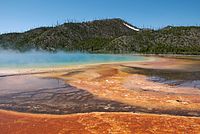Geobiology

Geobiology is a word used to describe the study of how living things (like plants, animals, and people) interact with rocks, soil, water, and all the other non-living parts of our planet. This might sound really boring, but it's actually really interesting!
Think about it like this: Have you ever gone to the beach and found a shell on the sand? That shell was once part of a living creature that lived in the ocean. When that creature died, its shell fell to the ocean floor and became part of the sediment, or dirt, on the ocean floor. Over time, that sediment turned into a rock. That rock might have eventually eroded away, and the shell could have ended up on a beach somewhere, where you found it!
Geobiologists study things like this to learn more about how the Earth works. They might also study tiny creatures called microbes that live in the soil and rocks. Some of these microbes can break down rocks into soil, which plants need to grow. Others can produce important minerals that are used in things like smartphones or wind turbines.
Overall, geobiology is all about understanding how living things and non-living things work together to shape our planet.
Think about it like this: Have you ever gone to the beach and found a shell on the sand? That shell was once part of a living creature that lived in the ocean. When that creature died, its shell fell to the ocean floor and became part of the sediment, or dirt, on the ocean floor. Over time, that sediment turned into a rock. That rock might have eventually eroded away, and the shell could have ended up on a beach somewhere, where you found it!
Geobiologists study things like this to learn more about how the Earth works. They might also study tiny creatures called microbes that live in the soil and rocks. Some of these microbes can break down rocks into soil, which plants need to grow. Others can produce important minerals that are used in things like smartphones or wind turbines.
Overall, geobiology is all about understanding how living things and non-living things work together to shape our planet.
Related topics others have asked about:
